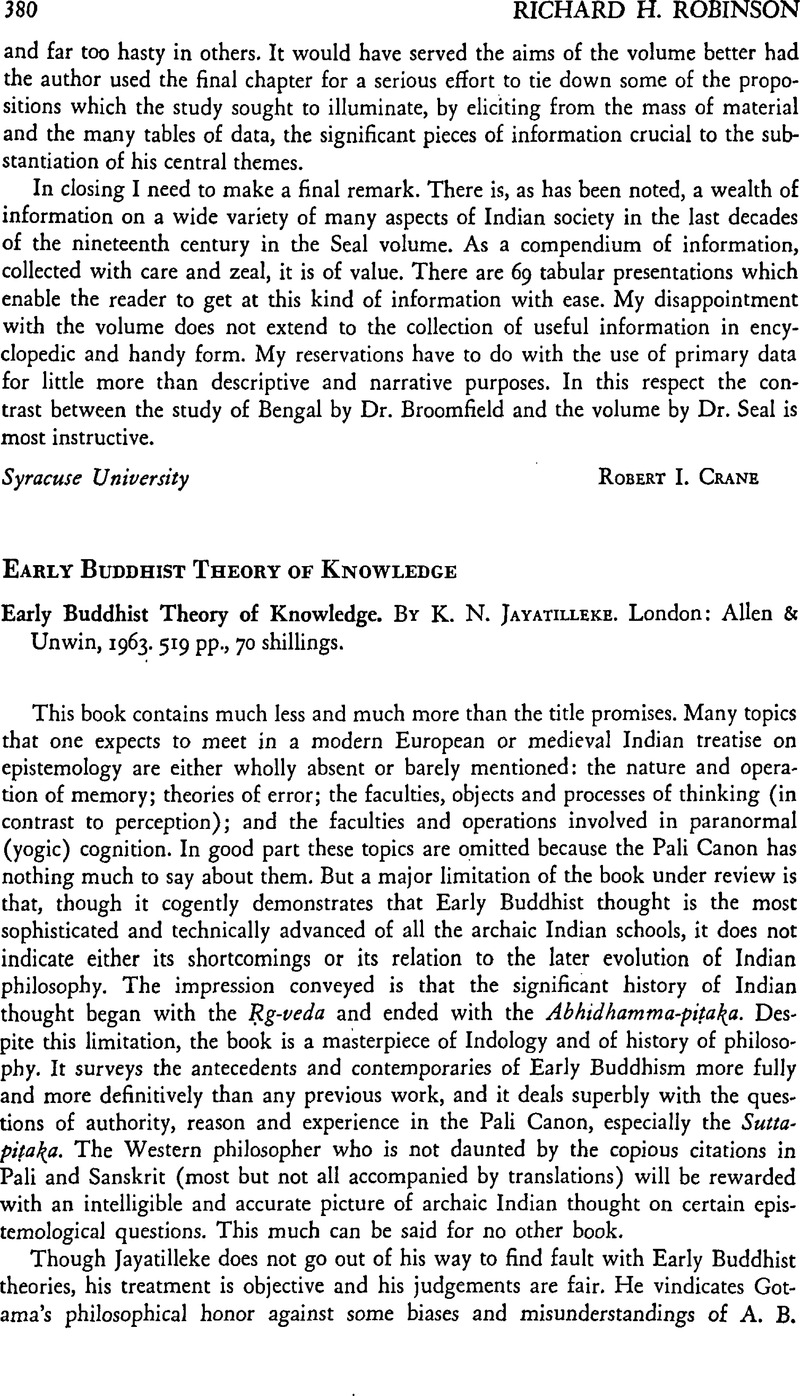No CrossRef data available.
Article contents
Early Buddhist Theory of Knowledge
Published online by Cambridge University Press: 23 March 2011
Abstract

- Type
- Review Articles
- Information
- Copyright
- Copyright © The Association for Asian Studies, Inc. 1969
References
1 Rhys-Davids, T. W., Buddhism (London: Society for Promoting Christian Knowledge, 1886), p. 176.Google Scholar
2 de La Vallée Poussin, Louis, The Way to Nirvāṇna, (Cambridge University Press, 1917), p. III.Google Scholar
3 de La Vallée Poussin, Louis, Nirvāṇna, (Paris: Beauchesne, 1925).Google Scholar
4 Jayatilleke, K. N., “Some Problems of Translation and Interpretation II,” University of Ceylon Review, 8 (1950), p. 45–55.Google Scholar
5 Raju, P. T., “The Principle of Four-Cornered Negation in Indian Philosophy,” Review of Metaphysics, Vol. 7, p. 694–713Google Scholar.
6 Bahm, Archie J., “Does Seven-Fold Predication Equal Four-Cornered Negation Reversed?”, PEW, VII, 3 & 4 (1957), p. 127–130.Google Scholar
7 Miyamoto, Shōson, “The Logic of Relativity as the Common Ground for the Development of the Middle Way,” in Buddhism and Culture, ed. Yamaguchi, Susumu, (Kyoto: 1960), p. 67–88.Google Scholar
8 Schayer, Stanislaw, “Altindische Antizipationen der Aussagenlogik,” Bulletin de l'Académie Polonaise, classe de philologie, (1933), p. 90–96.Google Scholar
9 Nakamura, Hajime, 1) “Kūkan no Kigō-ronrigaku-teki kaimei” [Some Clarifications of the Concept of Voidness from the Standpoint of Symbolic Logic], Indogaku Bukkyōgaku Kenkyü III, 1 (1954), p. 223–231Google Scholar. 2) “Buddhist Logic Expounded by Means of Symbolic Logic,” IBK VII, 1 (1958), p. 375–395.Google Scholar
10 Robinson, Richard H., “Some Logical Aspects of Nāgārjuna's System,” PEW VI, 4 (1957), p. 291–308.Google Scholar
11 Robinson, Richard H., “Mysticism and Logic in Seng-chao's Thought,” PEW VIII, 3 & 4 (1958–59) p. 99–120.Google Scholar
12 Majjhima Nikāya No. 72.
13 Jayatilleke, K. N., “The Logic of Four Alternatives,” PEW XVII, 1–4 (1967), p. 69–83.Google Scholar
14 Brahma-jāla Sutta, Dīgha Nikāya No. 1, PTS edition 1.31.
15 cf. Robinson, Richard H., “The Classical Indian Axiomatic,” PEW XVII, 1–4 (1967), p. 141.Google Scholar
16 PEW VI, 4, p. 299, 303.
17 cf. Yüan-k'ang, , PEW VIII, 3 & 4, p. 114Google Scholar, and Robinson, Richard H., Early Mädhyamīka in India and China, (Madison: University of Wisconsin Press, 1967), p. 135–136Google Scholar. Jayatilleke gives an example with “east” and “west,” but adduces no canonical or extracanonical instance.
18 Jayatilleke, book, p. 278. See Majjhima II. 197.
19 Saṃyutta IV, 400–401. cf. Étienne Lamotte, Traité de la grande vertu de Sagosse, (Louvain: Bureau du Mugéon, 1944). Vol. I, p. 32, n. 3.
20 Candrakīrti, , Prasannapadā Madhyamakavṛtti, ed. de La Vallée Poussin, L., (St. Pétersbourgh, 1903–1913). p. 354 ff.Google Scholar
21 Jayatilleke, book, p. 361–368. See Aṅguttara 1.60.
22 Candrakīrti, Prasannapadā 370.1, explains this as meaning that the skandhas, dhātus and āyatanas are real. Jayatilleke, PEW p. 82, mistranslates: “Nāgārjuna, however, says that according to the Buddha, propositions could be true, false, both true and false, and neither true nor false.”
23 Majjhima I, 240 ff. cf. Thomas, E. J., The Life of the Buddha, (London: Routledge & Kegan Paul, 1927), p. 63.Google Scholar
24 Mahāvagga I. S. 1–13.




